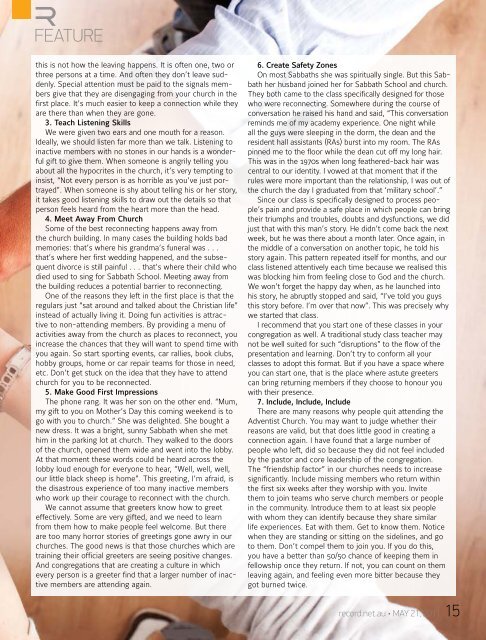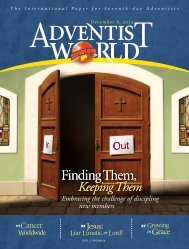Download RECORD as a PDF - RECORD.net.au
Download RECORD as a PDF - RECORD.net.au
Download RECORD as a PDF - RECORD.net.au
You also want an ePaper? Increase the reach of your titles
YUMPU automatically turns print PDFs into web optimized ePapers that Google loves.
FEATURE<br />
this is not how the leaving happens. It is often one, two or<br />
three persons at a time. And often they don’t leave suddenly.<br />
Special attention must be paid to the signals members<br />
give that they are disengaging from your church in the<br />
first place. It’s much e<strong>as</strong>ier to keep a connection while they<br />
are there than when they are gone.<br />
3. Teach Listening Skills <br />
We were given two ears and one mouth for a re<strong>as</strong>on.<br />
Ideally, we should listen far more than we talk. Listening to<br />
inactive members with no stones in our hands is a wonderful<br />
gift to give them. When someone is angrily telling you<br />
about all the hypocrites in the church, it’s very tempting to<br />
insist, “Not every person is <strong>as</strong> horrible <strong>as</strong> you’ve just portrayed”.<br />
When someone is shy about telling his or her story,<br />
it takes good listening skills to draw out the details so that<br />
person feels heard from the heart more than the head.<br />
4. Meet Away From Church <br />
Some of the best reconnecting happens away from<br />
the church building. In many c<strong>as</strong>es the building holds bad<br />
memories: that’s where his grandma’s funeral w<strong>as</strong> . . .<br />
that’s where her first wedding happened, and the subsequent<br />
divorce is still painful . . . that’s where their child who<br />
died used to sing for Sabbath School. Meeting away from<br />
the building reduces a potential barrier to reconnecting.<br />
One of the re<strong>as</strong>ons they left in the first place is that the<br />
regulars just “sat around and talked about the Christian life”<br />
instead of actually living it. Doing fun activities is attractive<br />
to non-attending members. By providing a menu of<br />
activities away from the church <strong>as</strong> places to reconnect, you<br />
incre<strong>as</strong>e the chances that they will want to spend time with<br />
you again. So start sporting events, car rallies, book clubs,<br />
hobby groups, home or car repair teams for those in need,<br />
etc. Don’t get stuck on the idea that they have to attend<br />
church for you to be reconnected.<br />
5. Make Good First Impressions <br />
The phone rang. It w<strong>as</strong> her son on the other end. “Mum,<br />
my gift to you on Mother’s Day this coming weekend is to<br />
go with you to church.” She w<strong>as</strong> delighted. She bought a<br />
new dress. It w<strong>as</strong> a bright, sunny Sabbath when she met<br />
him in the parking lot at church. They walked to the doors<br />
of the church, opened them wide and went into the lobby.<br />
At that moment these words could be heard across the<br />
lobby loud enough for everyone to hear, “Well, well, well,<br />
our little black sheep is home”. This greeting, I’m afraid, is<br />
the dis<strong>as</strong>trous experience of too many inactive members<br />
who work up their courage to reconnect with the church.<br />
We cannot <strong>as</strong>sume that greeters know how to greet<br />
effectively. Some are very gifted, and we need to learn<br />
from them how to make people feel welcome. But there<br />
are too many horror stories of greetings gone awry in our<br />
churches. The good news is that those churches which are<br />
training their official greeters are seeing positive changes.<br />
And congregations that are creating a culture in which<br />
every person is a greeter find that a larger number of inactive<br />
members are attending again.<br />
6. Create Safety Zones<br />
On most Sabbaths she w<strong>as</strong> spiritually single. But this Sabbath<br />
her husband joined her for Sabbath School and church.<br />
They both came to the cl<strong>as</strong>s specifically designed for those<br />
who were reconnecting. Somewhere during the course of<br />
conversation he raised his hand and said, “This conversation<br />
reminds me of my academy experience. One night while<br />
all the guys were sleeping in the dorm, the dean and the<br />
resident hall <strong>as</strong>sistants (RAs) burst into my room. The RAs<br />
pinned me to the floor while the dean cut off my long hair.<br />
This w<strong>as</strong> in the 1970s when long feathered-back hair w<strong>as</strong><br />
central to our identity. I vowed at that moment that if the<br />
rules were more important than the relationship, I w<strong>as</strong> out of<br />
the church the day I graduated from that ‘military school’.”<br />
Since our cl<strong>as</strong>s is specifically designed to process people’s<br />
pain and provide a safe place in which people can bring<br />
their triumphs and troubles, doubts and dysfunctions, we did<br />
just that with this man’s story. He didn’t come back the next<br />
week, but he w<strong>as</strong> there about a month later. Once again, in<br />
the middle of a conversation on another topic, he told his<br />
story again. This pattern repeated itself for months, and our<br />
cl<strong>as</strong>s listened attentively each time bec<strong>au</strong>se we realised this<br />
w<strong>as</strong> blocking him from feeling close to God and the church.<br />
We won’t forget the happy day when, <strong>as</strong> he l<strong>au</strong>nched into<br />
his story, he abruptly stopped and said, “I’ve told you guys<br />
this story before. I’m over that now”. This w<strong>as</strong> precisely why<br />
we started that cl<strong>as</strong>s.<br />
I recommend that you start one of these cl<strong>as</strong>ses in your<br />
congregation <strong>as</strong> well. A traditional study cl<strong>as</strong>s teacher may<br />
not be well suited for such “disruptions” to the flow of the<br />
presentation and learning. Don’t try to conform all your<br />
cl<strong>as</strong>ses to adopt this format. But if you have a space where<br />
you can start one, that is the place where <strong>as</strong>tute greeters<br />
can bring returning members if they choose to honour you<br />
with their presence.<br />
7. Include, Include, Include <br />
There are many re<strong>as</strong>ons why people quit attending the<br />
Adventist Church. You may want to judge whether their<br />
re<strong>as</strong>ons are valid, but that does little good in creating a<br />
connection again. I have found that a large number of<br />
people who left, did so bec<strong>au</strong>se they did not feel included<br />
by the p<strong>as</strong>tor and core leadership of the congregation.<br />
The “friendship factor” in our churches needs to incre<strong>as</strong>e<br />
significantly. Include missing members who return within<br />
the first six weeks after they worship with you. Invite<br />
them to join teams who serve church members or people<br />
in the community. Introduce them to at le<strong>as</strong>t six people<br />
with whom they can identify bec<strong>au</strong>se they share similar<br />
life experiences. Eat with them. Get to know them. Notice<br />
when they are standing or sitting on the sidelines, and go<br />
to them. Don’t compel them to join you. If you do this,<br />
you have a better than 50/50 chance of keeping them in<br />
fellowship once they return. If not, you can count on them<br />
leaving again, and feeling even more bitter bec<strong>au</strong>se they<br />
got burned twice.<br />
record.<strong>net</strong>.<strong>au</strong> • MAY 21, 2011 15

















